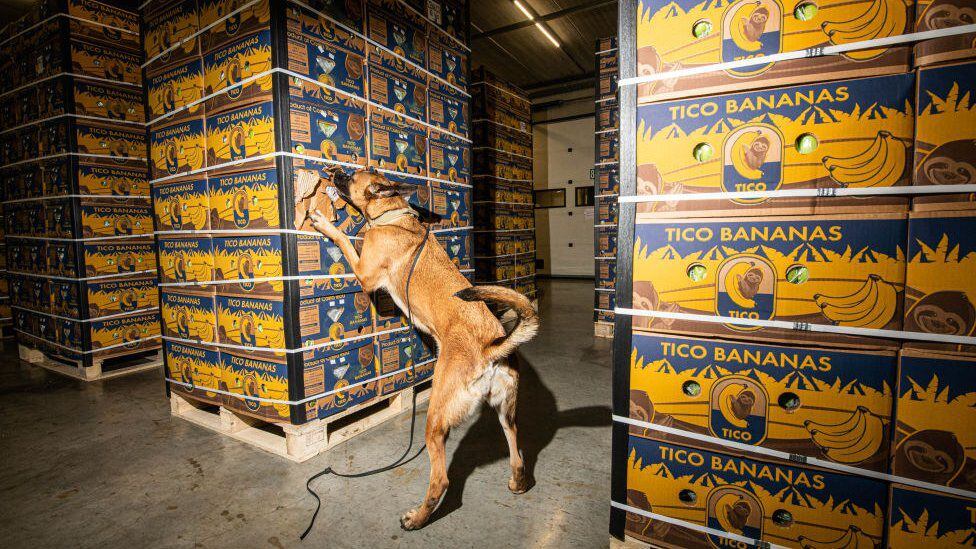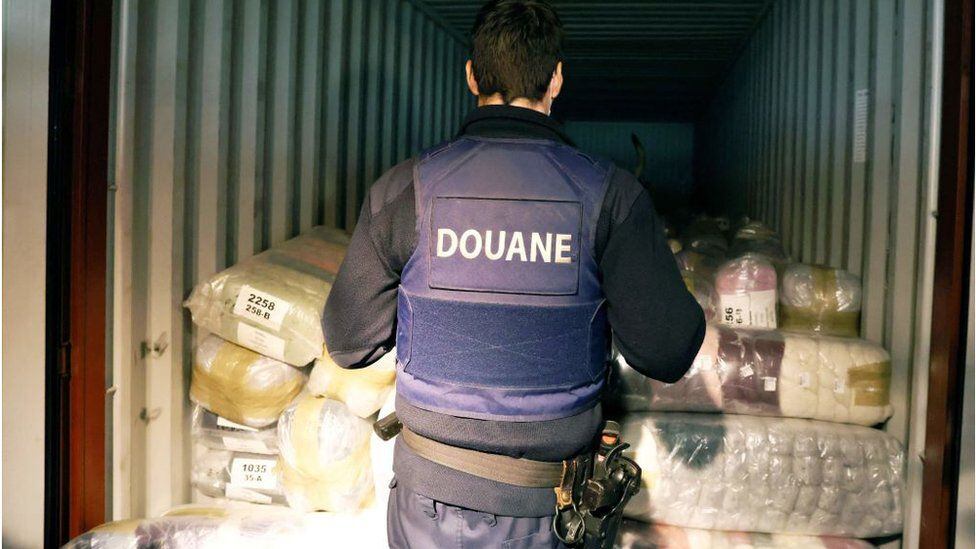The Belgian city of Antwerp is world famous for diamonds. But another business – less brilliant although equally or more lucrative – is taking over his reputation.
Its port, the second largest in Europe, and through which millions of containers pass each year, has become the main gateway for cocaine to the continent, displacing the Galician coasts in northwestern Spain, where until recently A few years ago, most of this drug slipped through.
LOOK: “The Parthenon Marbles belong to us”: the United Kingdom assures that they do not intend to return the works to Greece
In the last five years, one record after another of seizures has been broken.
In 2022 alone, the Belgian authorities discovered almost 110 tons of this drug, 23% more than the previous year, according to the latest data released by the Belgian Public Finance Service, an institution that supervises customs.
The figure represents 40% of all cocaine seized in Europe. The second largest port of entry, by far, is the Dutch port of Rotterdam, where in 2022 52.5 tons were found.
The amount of the caches is such that the Belgian authorities warned last year that their incinerators could not cope to destroy all the drugs that were intercepted.
It is estimated, however, that this amount only represents a tenth of all that arrives at the port.
Shipments come mainly from Brazil, Ecuador and Colombia and lately also Panama and Costa Rica.
But what makes the port of Antwerp such a coveted destination for drug gangs?
One reason, explains Florence Angelici, a spokeswoman for the Public Finance Service, is their huge expanse.
With 129 km2, the port of Antwerp is larger than the city of Paris.
Although it is smaller in tonnage than Rotterdam in the Netherlands, its surface area far exceeds that of its neighbor. It currently has 160 kilometers of docks, compared to 70 for the Dutch port.
“Roads pass through its interior, there are even towns that have remained inside because the port has grown a lot, and this makes it very difficult to monitor it,” Angelici explained to BBC Mundo.
The difficulty to control the entrances and exits in this megacity make it a paradise for drug dealerswho can collect all the information necessary to introduce and manage to get the drug out of the port.
Paul Meyer knows it like the back of his hand.
This Dutchman, who was sentenced in 2007 to 12 years in prison for smuggling huge amounts of drugs into Europe, is now remorseful in drawing attention to the strainer which, in his opinion, has become the port of Antwerp.
In the past, he and his group have tried to sneak the drug through the German port of Hamburg or the French port of Marseille. In Antwerp, he says, it was always much easier.
“The port is open. You go in and all the information you need to start something is there. You have the truckers, the people who work there, you can see the name of the ship,” Meyer told BBC European correspondent Nick Beake.
Until now, only 350 customs agents are dedicated to supervising the merchandise that arrives, a clearly insufficient figure that is going to be increased, according to the spokeswoman for the Public Finance Service, with another 108 “who will be dedicated only to drug control.”
fruit route
To the attractiveness of its difficult vigilance, it is added that it is a “historical route for the transport of fruits from Latin America to Europe. The port has refrigerated terminals and everything needed to receive these fruits,” adds Florence Angelici.

These established routes, which move millions of containers across the Atlantic Ocean every year, are taken advantage of by criminal networks, who manage to introduce cocaine into the containers that will later be consumed in Europe.
Drug dealers are imaginative, and Belgian customs have seen all kinds of tricks to hide the drug.
“They use all kinds of fruit, bananas, for example, and put cocaine in the middle of the boxes. Or they use pineapples, make a hole in them and put the drug inside the fruit,” says Angelici. This type of container is also refrigerated, “and in this cooling system there is a hole that is also used to hide the packages.”
Drug caches have been found inside wooden trunks and even, recalls the spokeswoman, “in clothing that had been soaked with liquid cocaine. When the customs agents opened the boxes, they only saw clothes, but when they did a more exhaustive control, they realized that the drug was in the fabric.”
However, due to the difficulties in guarding the port, one of the most widely used methods of introducing cocaine is much more direct.
It is known as the “rip on/rip off“either “blind hook”. It consists of placing packets of cocaine on top of normal merchandise in containers, without hiding them, often in sports bags that can be easily transported. In many cases, shippers are unaware that their cargo has been intercepted by drug traffickers.
“When they arrive at the port, there are people inside the terminals who quickly come to take them out of the containers. There may be 100 or 200 kilos, but they are very flexible,” explains Angelici.
Sometimes, these people, instead of removing the drug from the port, transfer it to other containers that they know will not be inspected, either because they have already been controlled, or because they do not require inspection, such as those that transport goods from a country to another of the European Union.

From Antwerp, which is located in the heart of Europe, it is very easy to reach the countries where it will be consumed, such as France or Germany.
But, according to Europol, the European Union Agency for Law Enforcement Cooperation, much of this drug is transported to Netherlandsfrom where the criminal groups based there distribute it throughout Europe.
Increased consumption
The drug flows despite the record number of seizures, and the European institutions know this because the price of cocaine on the street has not increased and has even decreased in some cases.
“We have noticed that In Latin America, harvesting methods have changed. Now they have genetically modified plants, and instead of one, they get two or three harvests a year,” says Angelici.
By producing more, more can be shipped. “And the more we seize, the more they lose, so they have to generate more profit to erase these losses,” the spokeswoman reasons. “This is another reason why more cocaine is coming in.”
Cocaine is one of the most widely used drugs in Europe.. Its use has increased significantly in recent years, partly because its price has fallen, according to the latest report on the cocaine market from the European Monitoring Center for Drugs and Drug Addiction, prepared with Europol.
In the networks where they buy, consumers often find themselves with offers and promotions 2×1, like the ones you can see in supermarkets. In many cases, you no longer have to go down a dark alley. A message through WhatsApp-type networks is enough, and the cocaine is sent to your home.
The report estimated that the cocaine business in Europe was worth more than $11.3 billion in 2020, a third of all drug trafficking, and behind only the cannabis business.
And where money moves on a grand scale, so does organized crime.

Antwerp, which until recently had been a relatively quiet city, has seen in recent years an explosion of violence directly related to the different drug gangs, with shootings and even explosions that have terrified its inhabitants.
His first fatality has been an eleven year old girlwho died in a shooting this week.
In the last five years there have been up to 200 violent incidents, something that was common in the neighboring Netherlands, but not in Antwerp.
Among the narco-terrorist gangs that dominate the business is the one known as “Mocro Maffia”, originating in the Netherlands and responsible for numerous murders, including that of the Dutch investigative journalist Peter R. de Vries and that of the lawyer Derk Wiersun, who represented a person who was going to testify against this group. Both took place in Amsterdam.
Even the Belgian Justice Minister, Vincent Van Quickenborne, has been forced to tighten his security after four Dutch suspects who allegedly planned to kidnap him were arrested.
Source: Elcomercio
I am Jack Morton and I work in 24 News Recorder. I mostly cover world news and I have also authored 24 news recorder. I find this work highly interesting and it allows me to keep up with current events happening around the world.

:quality(75)/cloudfront-us-east-1.images.arcpublishing.com/elcomercio/GE2DANRNGAYS2MJSKQYDAORRGQ.jpg)

:quality(75)/cloudfront-us-east-1.images.arcpublishing.com/elcomercio/NXQHO4NW75HLZC5E23KQKA232A.jpg)
:quality(75)/cloudfront-us-east-1.images.arcpublishing.com/elcomercio/XKRGSWWOCRE4NNJOF6SICIKFYQ.jpg)

:quality(75)/cloudfront-us-east-1.images.arcpublishing.com/elcomercio/2ZILPE2FSNFILBG3E7XU3MNVK4.jpg)
